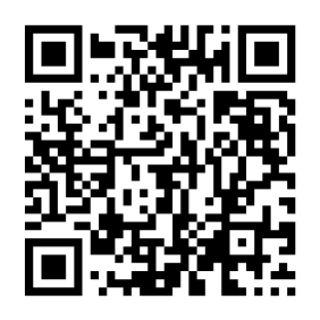PDF417 Barcode Scanner
Add PDF417 scanning to your mobile application or website
Trusted by
400+
global
industry leaders
Turn smartphones into fast & reliable PDF417 Barcode Reader
The Scanbot PDF417 Barcode Reader delivers exceptional performance even under challenging conditions—such as scanning faded or creased driver’s licenses carried in wallets, weather-damaged shipping labels on packages, or worn boarding passes printed on thermal paper. With a scan speed of just 0.04 seconds, your users get instant reads for seamless workflows.
Key benefits include:
- Offline scanning: The Scanbot SDK works 100% on-device, ensuring both uninterrupted performance and data security.
- Enterprise support: Questions or requests? Contact our technical support team. We’re happy to assist you.
- Flat pricing model: Cost stays the same no matter how much your user base or scanning volume grows.
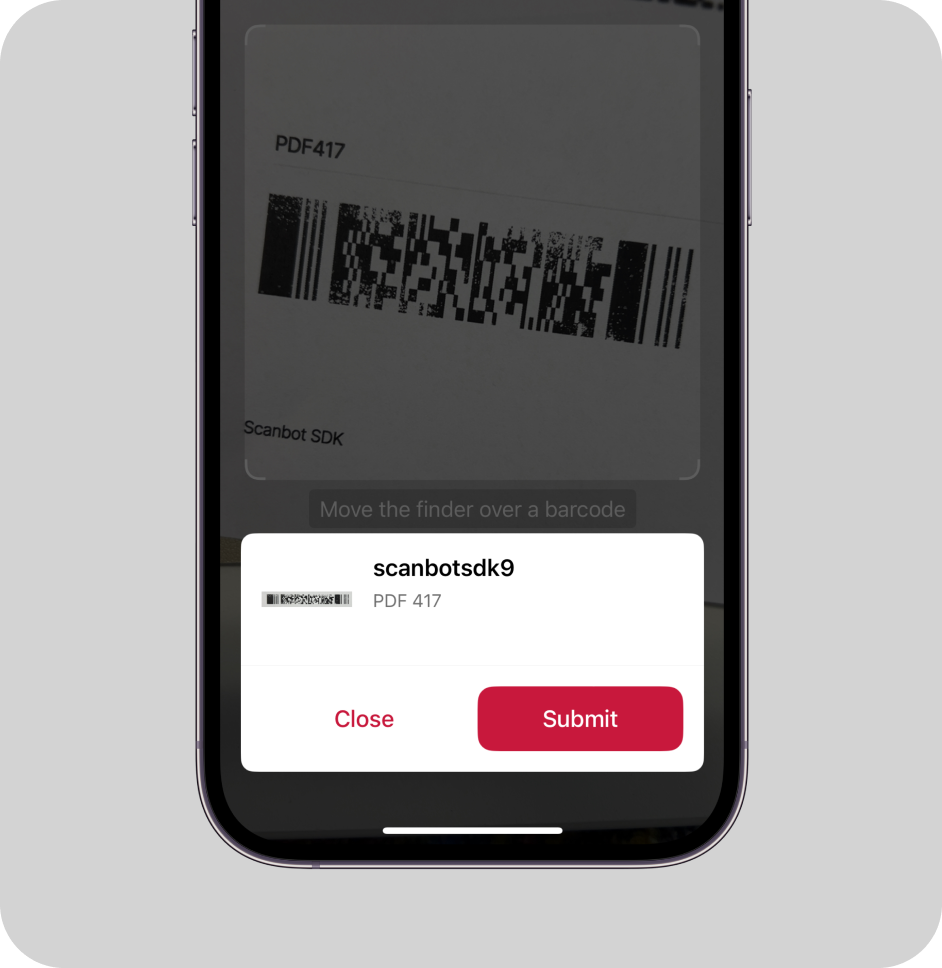

How this scanning tool works
Our free online barcode reader scans PDF417 codes directly through your mobile device’s camera or on imported images. This barcode scanner works in any browser, no app download or signup needed. Enjoy real-time camera view scanning or decode barcodes on pictures in seconds – just point your camera at the PDF417 barcode or import an image file to instantly access the data encoded.
This tool is powered by the Scanbot Barcode Scanner SDK!
(We don’t store any images or data you import. Everything stays on your device.)
Understanding PDF417 codes
What is a PDF417 code?
PDF417 is a two-dimensional (2D) stacked barcode standardized in ISO/IEC 15438. “PDF” stands for “Portable Data File,” reflecting its high data capacity of up to 2,725 numeric or 1,850 alphanumeric characters. These barcodes combine multiple rows of linear codes with built-in error correction, making them ideal for applications requiring reliable data storage in a compact format.
Structure and components
A PDF417 code consists of multiple linear barcodes stacked on top of each other, creating a 2D symbol. Each row in a PDF417 symbol contains the same structural elements:
- Start pattern: A distinctive pattern (one wide bar followed by three thin bars) signaling the beginning of the barcode.
- Stop pattern: This pattern marks the end of the barcode. Start and stop patterns tell scanners where the data codewords begin and end, but don’t encode data themselves.
- Left and right row indicators: These too serve as structural components, and don’t store any actual data like text or numbers. Instead, they contain metadata such as row count and level of error correction.
- Data codewords: This section stores the actual encoded information. Each row can hold up to 30 data codewords.
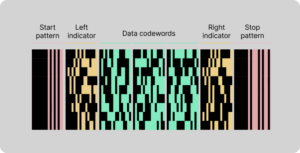
Each data codeword in a PDF417 barcode consists of four bars and four spaces, and has a total width of 17 modules (hence “417”). The width of the bars and spaces themselves ranges from 1 to 6 modules. Every codeword begins with a bar and ends with a space.
For example, in the image below:
- The first bar is 2 modules wide.
- The second bar is 1 module wide.
- The third bar is 2 modules wide.
- The fourth bar is 3 modules wide.
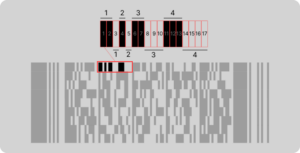
The codeword patterns translate to 929 unique values, numbered from 0 to 928. These values can represent various data types, including text, numbers, and binary information.
PDF417 codes consist of rows and columns. The barcode can contain 3 to 90 rows, with each row functioning as a narrow linear barcode. The size of the PDF417 depends both on how much data is encoded and on the error correction level.
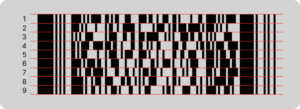
Error correction
PDF417 employs the Reed-Solomon algorithm with nine available security levels (0–8). The error correction level determines how many codewords are reserved for error correction (EC), ranging from 2 to 512. Higher levels provide greater protection but reduce data capacity.
| EC level | EC codewords generated | AIM recommendation |
| 0 | 2 | Not recommended |
| 1 | 4 | Not recommended |
| 2 | 6 | Minimum for 1–40 data codewords |
| 3 | 8 | Minimum for 41–160 data codewords |
| 4 | 16 | Minimum for 161–320 data codewords |
| 5 | 32 | Minimum for 321–863 data codewords |
| 6 | 64 | For higher security |
| 7 | 128 | For higher security |
| 8 | 512 | Maximum level |
Applications of PDF417 codes
Government and identity documents
PDF417 barcodes are the standard for encoding data on U.S. driver’s licenses and other state-issued identification cards. They were chosen for their compact format and high error tolerance.
Ticketing and travel
PDF417 barcodes are widely used for boarding passes, tickets, and visas. For airline boarding passes, an error correction level of 2–5 is recommended.
Logistics and transportation
In logistics, PDF417 barcodes streamline package labeling and tracking, ensuring efficient inventory management and shipment tracking. They are preferred for their high data density, storing comprehensive shipping information in a compact format.
Healthcare
PDF417 barcodes are commonly used for patient identification, medical records, and pharmaceutical tracking to comply with stringent industry regulations. With error correction and encryption capabilities, they are suited to applications that require reliable, secure data handling.
Advantages of PDF417 codes
- High data capacity: Store up to 2,725 numeric or 1,850 alphanumeric characters, ideal for complex data.
- Adjustable size: Customizable length and width make them suitable for various surfaces and applications.
- Built-in error correction: Robust Reed-Solomon error correction ensures data readability even when parts of the barcode are damaged.
- Versatility: Suitable for a wide range of industries and applications, from ID verification to postal tracking and logistics.
Why choose the Scanbot SDK for PDF417 Code scanning?
The Scanbot Barcode Scanner SDK is specifically designed to handle the challenges of decoding PDF417 codes in real-world scenarios.
What sets us apart:
- Exceptional performance: Reliably decodes even damaged, low-contrast or distorted barcodes.
- High-speed scanning: Read PDF417 codes in as little as 0.04 seconds.
- Cross-platform compatibility: Easily integrate with Android, iOS, cross-platform, web, Windows, and Linux platforms.
- Customizable UI: Customize the ready-to-use components to match your app or website design.
- Privacy-first: Operates offline for complete data security.
Whether your use case involves PDF417 codes, QR codes, or any other barcode, the Scanbot SDK delivers the accuracy, speed, and reliability you need to succeed.
Related Barcode Types
- Data Matrix Scanner
- QR Code Scanner
- Aztec Code Scanner
- Code 128 Scanner
- Code 39 Scanner
- EAN Scanner
- UPC Scanner
- Micro QR Code Scanner
- GS1 DataBar Scanner
- GS1 DataMatrix Scanner
- GS1-128 Scanner
- MaxiCode Scanner
- ITF Scanner
- Codabar Scanner
- Intelligent Mail Barcode Scanner
- rMQR Code Scanner
- Royal Mail Scanner
- Micro PDF417 Scanner
Frequently Asked Questions
Where is a PDF417 barcode used?
PDF417 is commonly used in IDs, driver’s licenses, and airline boarding passes. They are also found on shipping labels, and in the healthcare sector for patient identification, due to their high data capacity and error correction.
How can Scanbot SDK help you with PDF417 scanning?
The Scanbot SDK delivers exceptional performance in challenging environments, including damaged or curved barcodes, with a scanning speed of under 0.04 seconds for seamless workflows. Try it now with a free trial license.

